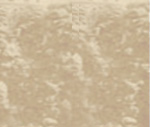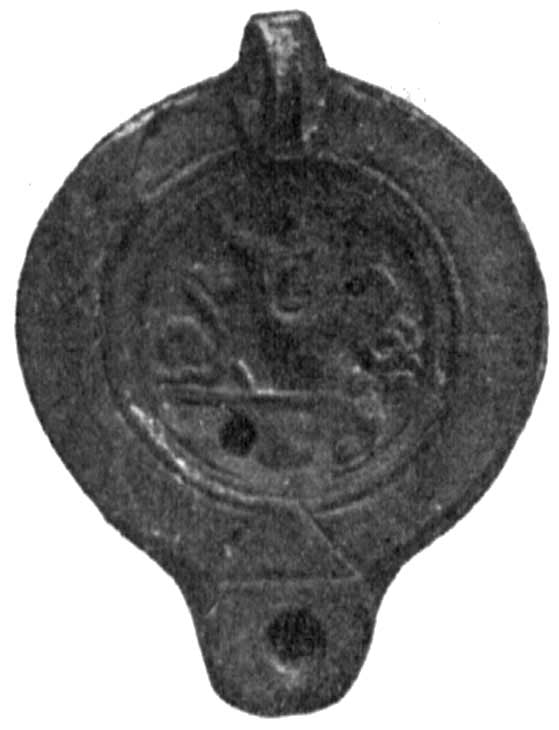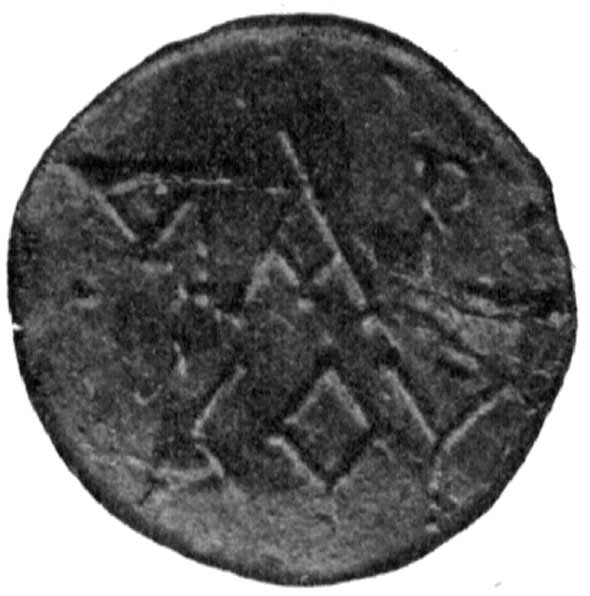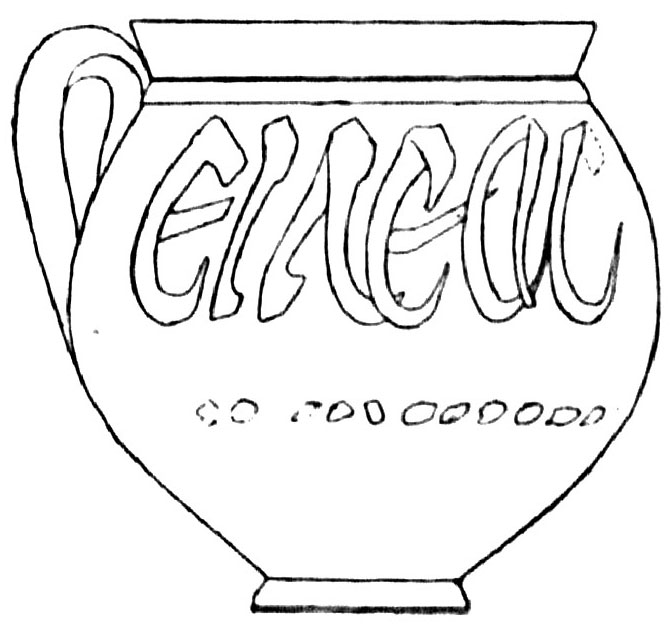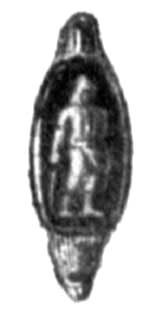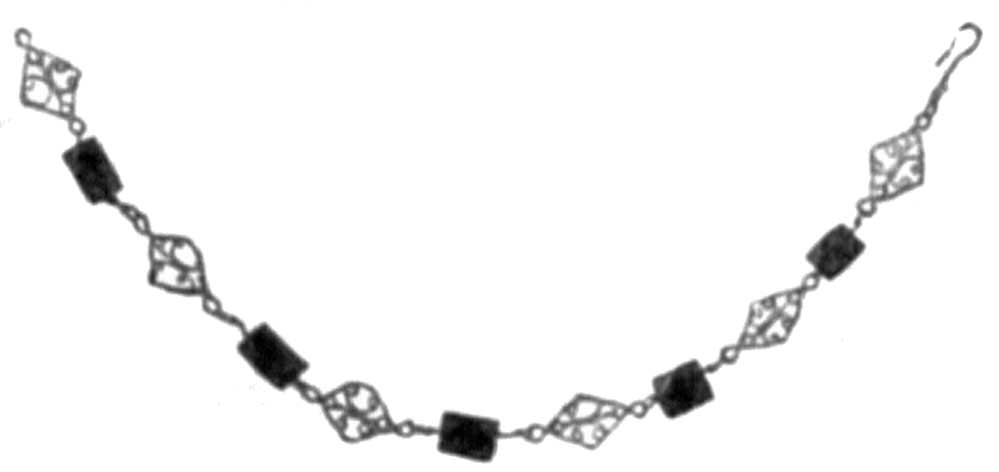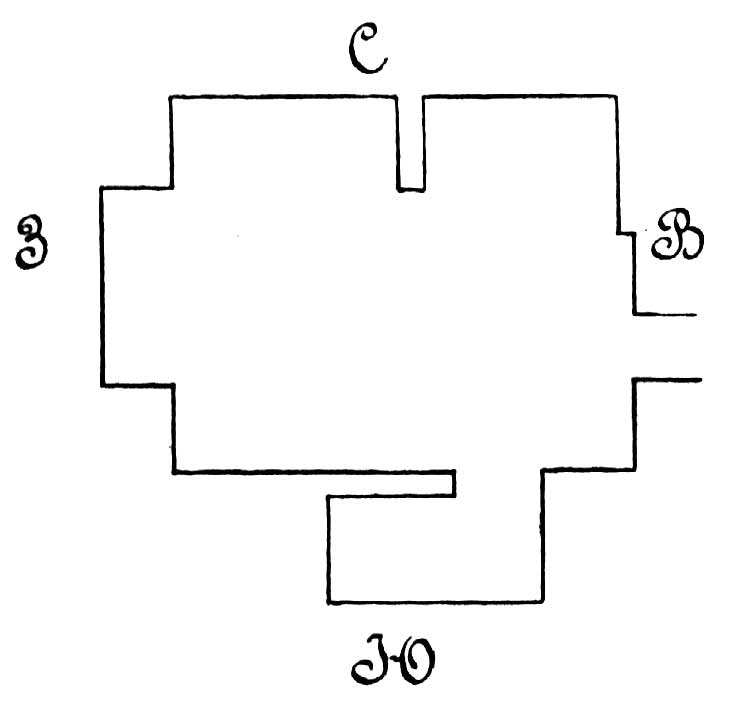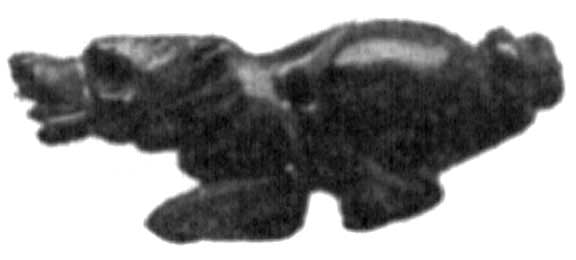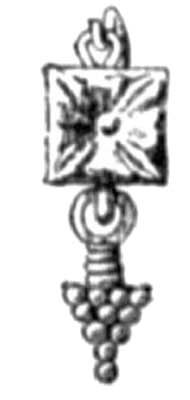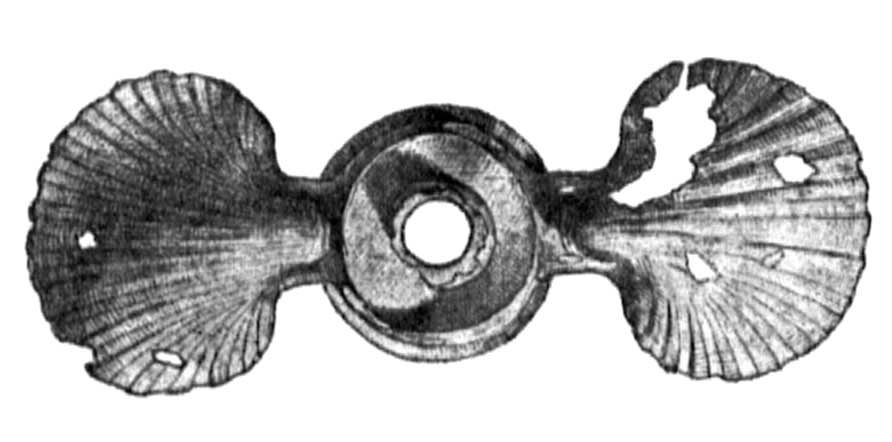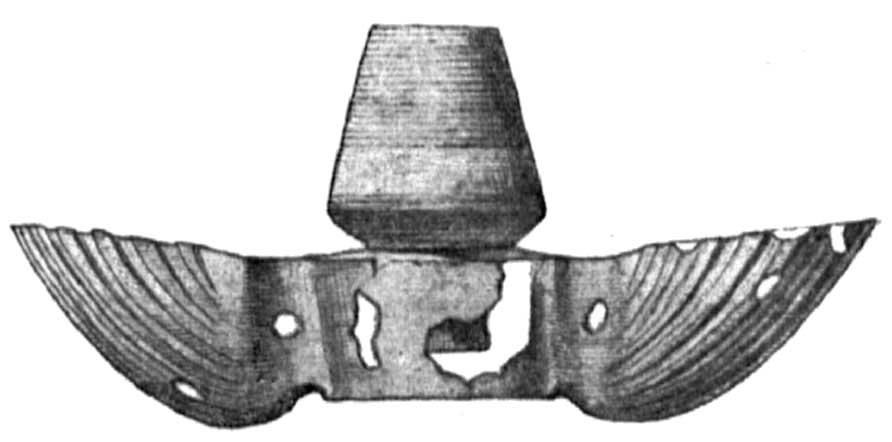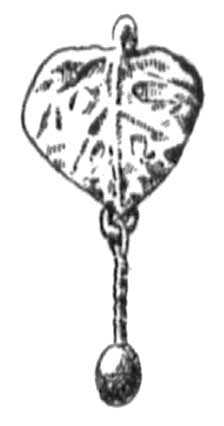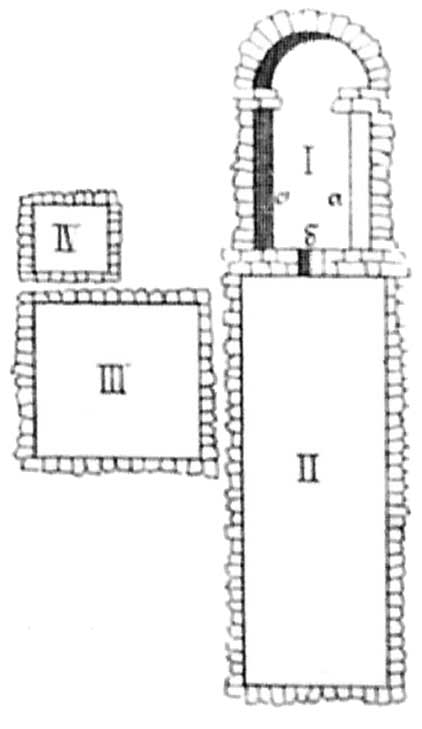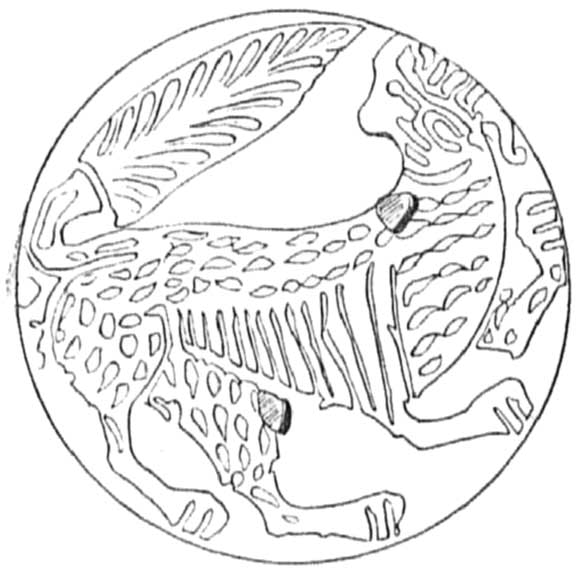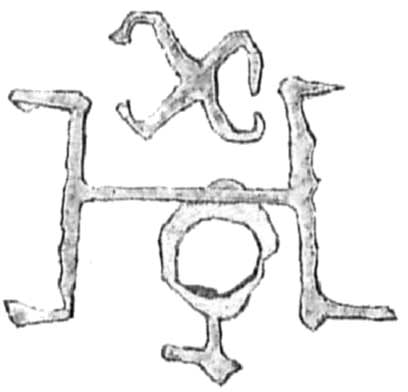1896 REPORT OF THE HEAD OF THE EXCAVATIONS IN CHERSONESOS K. K. KOSTSYUSHKO-VALYUZHINICH (PART 2)
- Similar tomb that contained: narrow-neck flat-bottomed gl<ass> balsamarium; single-handled earthen<ware> pitcher, which neck finishes in rosette; pendant in the form of toothed bron<ze> medallion, and 6 beads of paste (1 elongated, black with yellow strips, 2 ribbed, round, green, and 3 cylindrical, red).
- Similar tomb was located near the previous one, but it was oriented from the w<est> to the e<ast>. It contained: single-handled cup and red slip earthen<ware> bowl.
- -665. Two underground tombs, each contained skeleton of horse. There were two i<ron> rings that remained of bridle.
- . Underground tomb with two skeletons that laid one above another; the heads were oriented to the n<orth>. No grave goods were found with the skeletons.
- Underground tomb. The skeleton was accompanied with two narrow-neck handleless earthen<ware> vessels.
- This tomb is laid of big ancient Gr<eek> roof tiles. No grave goods were found with the skeleton.
 |
| Fig. 563 |
The necropolis mound in the area limited by vertical cliff from the e<ast> and group of tombs nos. 660-663, 666, 667, and 657 from the n<orth> contained the following finds: top fragment of grave stele of local sandstone (2' 9" х 11" х 5"), decorated with two rosettes and uninscribed pediment from above; bottom fragment of similar stele of the same material (1' 8" х 10" х 5"), with projection to fasten it in a horizontal slab, uninsribed; pediment for grave stele of the same material; 16 top pointed fragments of ancient Gr<eek> gravestones similar to the one pictured in 1891 Otchёt Arkheol<ogicheskoy> Kom<issii>, p. 18, fig.11, but with the projection broken off; 6 quadrangular stone slabs
(fig. 563)
, with quadrangular hole carved into for fixing the above mentioned pointed decorations vertically
[25].
; lead votive symbol with image of Artemis's head on one side and festooned bull's skull on the other; gl<ass> circle with one side convex; 3 mar<ble> tablets, damaged, with fragmented Gr<eek> names (these were inserted into big grave steles of local sandstones); 8 amphora handles (3 with traces of the names of astynomoi of Chersonesos, 1 with the name of astynomos of unclear colony, 3 with name and no indication of the office, and 1 with letter N); fragment of big roof tile with astynomos's name and butting bull; big roof tile with unreadable mark of the astynomos's name
[26]
; 4 bron<ze> coins of Chersonesos (Burachkov, <Op. cit.>, pl. XIV, 8 and 21, and unpublished one, portraying Artemis's head and butting bull), the legend is illegible; bron<ze> coin from Panticapaeum (Bur<achkov, Op. cit.>, pl. XX, 70); bron<ze> lioness's head, with the neck smoothly cut, having ½ versh<oks> in diameter; 20 smooth black slip earthen<ware> pottery shards; miniature handleless earthen<ware> juglet; 3 earthen<ware> sinkers for fishing nets in the form of truncated pyramids; fragment of Doric cornice, of sandstone, with one corner missing.
- This catacomb is 3 arch<ines> and 12 versh<oks> l<ong>, 4 arch<ines> w<ide>, and 2 arch<ines> and 6 versh<oks> h<igh>; it has a passageway to the e<ast> and 3 niches, and was plundered. On the floor, there were half-rotted coffin boards, and on the shelves were heaps of bones and earthen<ware> pottery: 3 single-handled juglets; 5 single-handled cups; double-handled cup with roughly scratched images, of two towers crowned with cross on one side
(fig. 564A)
, and nimbate human figure on the other side
(fig. 564б)
; 5 earthen<ware> lamps without images. Removed and sieved soil contained: g<old> earring in the form of openwork circle, with small cameo of bluish chalcedony portraying hum<an> head (of the type popular in Chersonesos) inserted in its centre; pair of miniature child's earrings of gold wire; 2 g<old> impressions of coins with illegible images; oval plain carnelian for signet-ring; bron<ze> medallion in the form of unreadable coin framed with silv<er> border; gl<ass> ribbed bracelet, without any trace that its ends were joint together alike the bracelets that were uncovered from the necropolis before; plain sil<ver> finger-ring; ir<on> finger-ring; bron<ze> tongs with flat pliers; 4 bron<ze> belt buckles; b<one> handle for small closed bell; fragment of footwear sole, probably a little worn, as impressed strips remained below; earthen<ware> spindle whorl; 50 beads (1 big round of rock crystal; 1 of green glass in the form of tetradecahedron; 1 long of multicolored paste; 3 of paste, round, with multicolored eyes; 2 flat amber, and 42 fine round, of gl<ass>); bron<ze> straight key; 2 bron<ze> coins of Chersonesos (Bur<achkov, Op. cit.>, pl. XVI, 108); Greek bron<ze> coin, completely worn off, with countermark in the form of a head; 2 bron<ze> coins of the emperors Gratian (375-383) and Arcadius (395-408).
 |
 |
| Fig. 564a |
Fig. 564б |
- This catacomb is 4 arch<ines> l<ong>, 3 arch<ines> and 14 versh<oks> w<ide>, and 2 arch<ines> and 4 versh<oks> h<igh>, with the passageway to e<ast> and 3 niches; it is plundered. On the floor, there were boards for 3 coffins, and on the shelves there was multitude of disarticulated bones and earthen<ware> pottery (3 single-handled juglets; 3 single-handled cups; narrow-neck handleless vessel); 5 plain earthen<ware> lamps; earthen<ware> lamp with relief image of Jupiter and Leda, of extremely rough workmanship. Removed and sieved soil contained: pair of earrings in the form of hemisphere of thin g<old> plate, with wire hook; g<old> unreadable impression of coin; plain bron<ze> finger-ring; gl<ass> stick fragment; 29 beads (1 chalcedonic elongated, 1 flint round, 2 paste with multicolored eyes, 4 of paste, ribbed, of green color, 8 gl<ass> in the form of thin tubes, 2 tetradecahedral gl<ass>, 8 fine circular gl<ass>, 3 flat amber); 2 gl<ass> pierced beads in the form of bisected grooved ball with two holes; 3 bron<ze> coins of Chersonesos (Bur<achkov, Op. cit.>, pl. XVI, 108, 110 and 111) and bron<ze> Roman coin dated to the 30 Tyrants period.
- This catacomb is 3 arch<ines> and 10 versh<oks> l<ong>, 4 arch<ines> and 6 versh<oks> w<ide>, and 2 arch<ines> and 6 versh<oks> h<igh>, with the passageway to e<ast> and 3 niches; it was plundered. It contained nothing but bones and earthen<ware> pottery shards.
- This catacomb is 4 arch<ines> and 5 versh<oks> long, 3 arch<ines> and 12 versh<oks> w<ide>, and 2 arch<ines> and 5 versh<oks> h<igh>, with the passageway to e<ast> and 3 niches. On the shelves, there were heaps of bones and earthen<ware> pottery (3 single-handled juglets, 6 single-handled cups, double-handled cup, handleless cup, and bowl); gl<ass> bottle; 4 plain earthen<ware> lamps; 9 child's earthen<ware> lamps, of very rough workmanship; earthen<ware> lamp with roughly-made relief image of man, standing, with the arm raised, and boa to the right and a monster (like sea horse) to the left, and child or monkey sitting near his feet
(fig. 565a)
, with the maker's name
 impressed on the lamp bottom
(fig. 565б)
.
impressed on the lamp bottom
(fig. 565б)
.
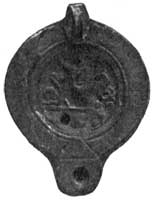 |
 |
| Fig. 565а |
Fig. 565б |
Removed and seived soil contained: 3 g<old> unreadable impressions of coins; plain sil<ver> finger-ring; bron<ze> ring-shaped earring; 2 bron<ze> pendants (1 in the form of toothed medallion, another in the shape of knobbed ring); straight bron<ze> key; bron<ze> bell; 2 bron<ze> belt buckles; bron<ze> needle for knitting nets; bracelet composed by 10 big glass pierced beads in the form of bisected grooved balls with two holes each; 3 amphora-shaped amber pendants; 109 beads (1 carnelian tetradecahedrons, 9 elongated amber, 6 flat gl<ass>, of blue color, 24 gl<ass> in the shape of flat tubes, 1 elongated jet, 68 of multicolored glass); 4 bron<ze> coins of Chersonesos (Bur<achkov, Op. cit.>, pl. XVI, 97, 106, 112 and 118); bron<ze> coin of a son of Constantine the Great, and 2 bron<ze> coins of Theodosius the Great (378-395).
All the 4 catacombs are located along the single line drawn from n<orth> to s<outh>, each having passageway to e<ast> and 3 niches. In the same strip, in the mound 2 arch<ines> deep, there were: small gravestone of local stone in the shape of portico with columns and pediment; 2 pointed stone decorations for ancient gravestones; stone slab with a hole carved in it to fasten the above-mentioned decorations; fragment of stemmed earthen<ware> double-handled vase, covered by brown slip with metal luster.
- Underground tomb that contained: red slip plate; black slip earthen<ware> tureen; red-slip single-handled vessel with spout and short neck ending with saucer and with sieve in the middle.
- This child's tomb was laid of four big roof tiles. The skeleton was not accompanied by grave goods.
- Underground tomb with single skeleton accompanied by black slip earthen<ware> juglet with brown design, greatly damaged.
- This tomb (3 arch<ines> х 1 arch<ine> х 12 versh<oks>) was carved into bedrock and covered with slabs. Cremated skeleton was accompanied by single-handled juglet and earthen<ware> lamp with relief image of rosette with 12 petals.
- This single-handled earthen<ware> urn appeared to contain nothing but cremated bones.
- Underground tomb. The skeleton with the head oriented to s<outh> was not accompanied by grave goods.
- Similar tomb for a child. It contained nothing.
- This catacomb is 4 arch<ines> and 10 versh<oks> long, 6 arch<ines> w<ide>, and 2 arch<ines> and 8 versh<oks> h<igh>, with the passageway to the e<ast>, 3 bed-shaped niches, and quadrangular support pillar carved from the same bedrock. If one starts from the entrance, on the floor, there were 2 skeletons on either side of the pillar, with the heads to the e<ast>; behind the pillar, there were 2 more skeletons with the heads oriented to s<outh>; and, finally, on the beds there were 5 skeletons (two, two and one, counting from s<outh> to n<orth>). Bones and coffin boards decayed, bronze is covered with thick layer of oxide, and earthen<ware> pottery with white compact film. On the floor and on the beds there were: 4 earthen<ware> single-handled juglets; damaged miniature earthen<ware> single-handled juglet; 15 single-handled earthen<ware> cups; 3 single-handled earthen<ware> cups of black color
(fig. 566a and fig. 567a)
, two of which with Greek inscriptions carelessly made with yellow pigment
(fig. 566б and fig. 567б)
;
 |
 |
| Fig. 566a |
Fig. 566б |
 |
 |
| Fig. 567a |
Fig. 567б |
5 earthen<ware> bowls, one filled with chestnuts; 11 plain earthen<ware> lamps; lamp with image of vine wreath with maker's name below; bronze brooch; 2 bron<ze> child's bracelets; bron<ze> earring in the form of big twisted ring with oval socket where probably was enamel; 2 bron<ze> buckles (one for belt and another for shoe); ir<on> finger-ring (the stone from its socket is missing); bron<ze> tube with two eyelets on the ends; bron<ze> bell; as much as 100 beads, namely 3 of b<one> in the shape of tubes, 11 of paste with multicolored eyes and strips, and 83 of paste (17 specimens of red color, 16 specimens of yellow color, and 50 of blue color); bracelet consisting of 19 jet flat square pierced beads; 2 bron<ze> coins of Chersonesos (Bur<achkov, Op. cit.>, pl. XVI, 108 and 113); undeterminable bron<ze> Gr<eek> coin, and 2 bron<ze> late Roman coins.
 |
| Fig. 568 |
- This catacomb is 3 arch<ines> and 14 versh<oks> l<ong>, 3 arch<ines> and 7 versh<oks> w<ide>, and 2 arch<ines> and 6 versh<oks> h<igh>, with the passageway to e<ast> and no niches. On the floor, there were 4 skeletons: 2 at the western wall, with the heads to s<outh>, and 2 at the northern wall, with the heads to e<ast>. No boards remained from the coffins. The skeleton laying in the north-west corner was accompanied with small gold finger-ring with cameo (standing figure, in greenish layer of agate above dark background;
(fig. 568)
; g<old> oval leaf for covering mouth; pair of sil<ver> child's bracelets; single-handled earthen<ware> cup; 2 earthen<ware> lamps with no decorations; 6 gl<ass> beads of blue color. The other skeletons were not accompanied with grave goods.
- Underground tomb. The skeleton with the head oriented to s<outh> was accompanied with bron<ze> Gr<eek> coin of extremely bad preservation, with traces of head to right on one side, and countermark in the form of a monogram in circle on the other.
- The catacomb is 4 arch<ines> and 2 versh<oks> long, 4 arch<ines> and 4 versh<oks> w<ide>, and 2 arch<ines> and 8 versh<oks> h<igh>, with the passageway to the e<ast> and 3 niches; it was plundered and filled with soil and fine stone. It contained nothing but bones and simple earthen<ware> pottery shards.
- The catacomb is 3 arch<ines> and 4 versh<oks> long, 3 arch<ines> w<ide>, and 2 arch<ines> and 6 versh<oks> high, with the passageway to e<ast> and 3 niches. As the passageway was not covered with slab densely, ground and water penetrated to the catacomb and covered its footing with mud as deep as 6 versh<oks>. The finds: g<old>finger-ring with round blue glass; hemispherical earring of thin glass plate and wire hook; medallion consisting of unreadable sil<ver> Roman coin, framed in g<old> with eyelet; 2 pendants in the form of plain egg-shaped garnets framed in g<old> with wide eyelet on top; 4 unreadable g<old> impressions of coins; bracelet consisting of 6 g<old> plates in the shape of openwork parallelograms, connected with wires pierced through 5 flat carnelian beads in the form of tetradecahedrons
(fig. 569)
;
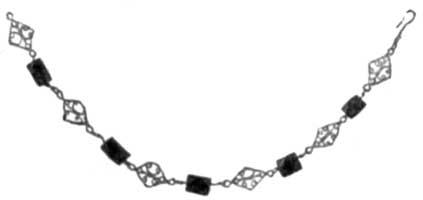 |
| Fig. 569 |
necklace consisting of thin g<old> chain with 30 tetradecahedral flat pierced beads of blue glass put on this chain with equal intervals between each other; big flat-bottom glass balsamarium; 3 glass bottles; single-handled earthenware pitcher; 2 narrow-neck handleless earthen<ware> vessels; 4 single-handled earthen<ware> cups; 3 earthen<ware> bowls; 22 plain earthen<ware> lamps, 5 of which are of very rough workmanship; earthen<ware> lamp with relief image of rosette with 14 petals; bron<ze> bracelet; plain sil<ver> finger-ring; pair of child's bron<ze> ring-shaped earrings; 2 bron<ze> belt buckles; iron knife blade; small bron<ze> pyramid-shaped bell; big paste bead with multicolored strips; multitude of jet and amber beads, which fell into pieces because of dampness; 4 bron<ze> coins of Chersonesos (Bur<achkov, Op. cit.>, pl. XVI, 108, 109 and 110); big, completely worn off bron<ze> coin with countermark in the form of Artemis standing within dotted circle (s<ee> Burachkov, <Op. cit.>, pl. XVI, cat. no. 120), and bron<ze> late Roman coin.
- The tomb was carved in bedrock and contained round-bottom balsamarium and single-handled earthen<ware> juglet.
- Similar tomb that contained single-handled earthen<ware> cup and 2 earthen<ware> bowls.
- Underground tomb that contained handleless earthen<ware> cup and earthen<ware> bowl.
- Similar tomb with one skeleton and no grave goods.
- The tomb was carved in bedrock and contained one skeleton and no grave goods.
- Underground tomb with one skeleton and no grave goods.
- -692. Two earthen<ware> single-handled urns. These contained nothing but cremated bones.
- The tomb was cut into bedrock and covered with long narrow roof tiles that covered big ancient Greek roof tiles at junctions. Such a tomb is uncovered for the first time. The singular skeleton was not accompanied by grave goods.
- Underground tomb with cremated skeleton accompanied with plain sil<ver> finger-ring.
- The tomb was laid of big roof tiles. The skeleton was not accompanied with grave goods.
- Underground tomb contained cremated skeleton accompanied with: minor bron<ze> brooch; 2 bron<ze> mushroom-shaped cuff links; big bron<ze> ring, probably for horse harness; 2 bron<ze> fragments of horse bits; plain earthen<ware> lamp, and 2 single-handled earthen<ware> juglets.
- Similar tomb contained single skeleton accompanied by gl<ass> balsamarium with pointed bottom alike that of Greek amphorae.
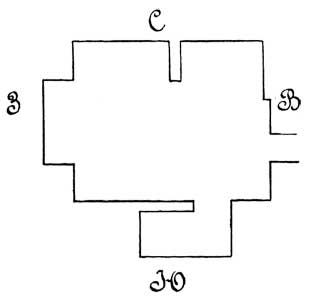 |
| Fig. 570 |
- This catacomb is 5 arch<ines> and 14 versh<oks> long, 4 arch<ines> and 5 versh<oks> w<ide>, and 2 arch<ines> and 10 versh<oks> h<igh>, with the passageway to the e<ast>
(fig. 570)
, three niches of common form, and one big room-shaped niche (3 arch<ines> l<ong>, 2 arch<ines> w<ide>, and 1 arch<ine> and 6 versh<oks> h<igh>) in the south wall, with the passageway 1 arch<ine> and 6 versh<oks> х 1 arch<ine> and 4 versh<oks>, at the height of 1 arch<ine> and 5 versh<oks> from the footing. This big niche contained 3 skeletons, and the rest 3 niches had 4 skeletons each; on the floor to the right from the entrance, at the n<orth> wall, there was wooden coffin, with the head to the w<est>, that actually kept its form (2 arch<ines> and 10 versh<oks> l<ong>, 11 ½ versh<oks> w<ide> at the head and 7 ½ versh<oks> at the foot, and 8 ½ versh<oks> h<igh> at the head and 7 versh<oks> at the foot), resting on the stones put under it. The sides consisted of whole board, the cover and bottom were knocked up of two boards with wooden tenons and rabbets; corner interlocking joints were made firmly and in a beautiful way. In the coffin, there were rotten bones of single skeleton (of a man, according to grave goods), with remains of cloths, short black hair, and leather shoe soles (5 ½ versh<oks> long). At the head, there were 4 earthen<ware> lamps without images; wooden comb with wider spaced teeth (wooden combs from the Byzantine period are all double-sided) and bron<ze> coin of Chersonesos with image of Artemis striking deer on one side and butting bull and inscription
 on the other (in Burachkov's, <Op. cit.>, pl. XVI, cat. nos. 103-104, there are similar coins but without inscription around and of more rough style). Lower than the coffin, all over the floor, there was layer of raw clay 3-4 vershoks deep containing scattered bones without any trace of coffins: these obviously are burials from an earlier period when the catacomb itself was constructed. The other niches contained: 3 hemispherical earrings of thin g<old> plate with wire hook; child's earring of g<old> wire; g<old> pendant in the form of a tube with two wide loops at the sealed ends; 6 g<old> impressions of coins (two portraying human face to the right, the others are illegible); sheet from oval g<old> badge to cover child's mouth; amber finger-ring that appeared for the first time; sil<ver> finger-ring with oval carnelian with carved image of a man at the altar; 3 single-handled earthen<ware> juglets; single-handled grooved earthen<ware> juglet; 5 single-handled earthen<ware> cups; grooved earthen<ware> handleless cup; earthen<ware> bowl; 22 earthen<ware> lamp without images; child's bron<ze> bracelet; 16 bron<ze> belt buckles; iron knife blade; bracelet that consisted of 16 jet beads, heavily damaged, in the form of ribbed hemispheres; 12 amphora-shaped amber pendants; 81 beads (tetradecahedral of carnelian; 2 tetradecahedral, of blue glass; 32 round, ribbed, of green paste; 16 round, plain, of dark brown paste; 2 of black paste with multicolored eyes; 22 flat, round of blue glass, and 6 oval); 10 flat amber circles; 6 jet tubes; 4 bron<ze> coins of Chersonesos (two alike Bur<achkov, Op. cit.>, pl. XVI, 101, one of which is a variant as the inscription
on the other (in Burachkov's, <Op. cit.>, pl. XVI, cat. nos. 103-104, there are similar coins but without inscription around and of more rough style). Lower than the coffin, all over the floor, there was layer of raw clay 3-4 vershoks deep containing scattered bones without any trace of coffins: these obviously are burials from an earlier period when the catacomb itself was constructed. The other niches contained: 3 hemispherical earrings of thin g<old> plate with wire hook; child's earring of g<old> wire; g<old> pendant in the form of a tube with two wide loops at the sealed ends; 6 g<old> impressions of coins (two portraying human face to the right, the others are illegible); sheet from oval g<old> badge to cover child's mouth; amber finger-ring that appeared for the first time; sil<ver> finger-ring with oval carnelian with carved image of a man at the altar; 3 single-handled earthen<ware> juglets; single-handled grooved earthen<ware> juglet; 5 single-handled earthen<ware> cups; grooved earthen<ware> handleless cup; earthen<ware> bowl; 22 earthen<ware> lamp without images; child's bron<ze> bracelet; 16 bron<ze> belt buckles; iron knife blade; bracelet that consisted of 16 jet beads, heavily damaged, in the form of ribbed hemispheres; 12 amphora-shaped amber pendants; 81 beads (tetradecahedral of carnelian; 2 tetradecahedral, of blue glass; 32 round, ribbed, of green paste; 16 round, plain, of dark brown paste; 2 of black paste with multicolored eyes; 22 flat, round of blue glass, and 6 oval); 10 flat amber circles; 6 jet tubes; 4 bron<ze> coins of Chersonesos (two alike Bur<achkov, Op. cit.>, pl. XVI, 101, one of which is a variant as the inscription
 begins not from the left but from the right of standing Artemis; two others see at the same plate under nos. 106 and 110); 8 bron<ze> coins of Theodosius the Great (378-395), Arcadius (395-408), Leo I (457-474), and 5 late Roman coins.
begins not from the left but from the right of standing Artemis; two others see at the same plate under nos. 106 and 110); 8 bron<ze> coins of Theodosius the Great (378-395), Arcadius (395-408), Leo I (457-474), and 5 late Roman coins.
- Underground tomb with cremated skeleton accompanied with no grave goods.
 |
| Fig. 571 |
- The catacomb is 4 arch<ines> and 10 versh<oks> l<ong>, 5 arch<ines> and 5 versh<oks> w<ide>, and 2 arch<ines> and 9 versh<oks> h<igh>; the passageway is oriented to the e<ast>; there is only one niche in the n<orth> side. On the floor, there were 3 skeletons with the heads to the w<est> and covered with thin layer of soil. The finds: earring of thin gold wire; medallion that consists of unreadable silver Roman colonial coin framed in g<old> with wide eyelet, emperor's bust is placed upside down, similarly to the g<old> medallion uncovered in 1891 from tomb no. 3
[27]
; 2 g<old> impressions of coins (one portrays human head facing right, another is unreadable); plain oval carnelian probably from a medallion; silv<er> finger-ring with carnelian gem with carved dolphin; black glass finger-ring with roughly made in relief head of Medusa (?) of yellow glass; round sil<ver> pendant with wide eyelet; amber pendant in the form of laying dog
(fig. 571)
; plain bron<ze> finger-ring; ir<on> finger-ring; single-handled earthen<ware> juglet; single-handled earthen<ware> cup; big globular gl<ass> bottle; 2 earthen<ware> lamps without images; earthen<ware> plate; 2 flints; various beads (9 of blue glass, in the form of tetradecahedrons; 3 elongated, of red paste; 22 of flint, greenish, fine); 3 bron<ze> coins of Chersonesos (Bur<achkov, Op. cit.>, pl. XVI, 110 and 114, 2 spec<imens>) and 2 bron<ze> coins of Theodosius the great and Arcadius.
- Underground tomb with single skeleton accompanied with black slip earthen<ware> bowl, greatly damaged.
- -708. Seven underground tombs, each with single skeleton and no grave goods.
- Single-handled earthen<ware> urn that contained nothing but cremated bones.
- This carved-into-bedrock tomb contained single-handled earthen<ware> cup.
- -714. Four underground tombs, each with single skeleton and no grave goods.
- This tomb is laid of nine stone slabs with holes carved in them, taken from the ancient Gr<eek> gravestones. Nothing was found in it
[28]
.
- -717. Two underground tombs, either with single skeleton and no grave goods.
- -719. Two tombs were carved into bedrock, these were not covered with slabs and were plundered. They do not contain goods.
- Underground tomb with single skeleton accompanied with earthen<ware> single-handled cup.
- This tomb is laid of stone slabs; it is plundered and destroyed. There were three skeletons and no grave goods.
The mound covering this sector of the necropolis contained: 2 pointed stone decorations for ancient Gr<eek> gravestones; stone gravestone in the form of portico with columns and cornice; 3 gravestones of local stone (the first is 1' 8" х 10" х 5", portraying woman's bust en face, of rough workmanship; the second is 2' 1" х 1' 1" х 6", with extremely rough image of man's bust en face; the third is 1' 2" х 1' 4", with rough image of two busts, big and small, en face, close to each other
[29]
; fragment (1 arch<ine> high) of marble statue of naked muscular man leaning against a tree (the head, legs and right hand are missing), who holds a beast, perhaps lynx that grabbed his chest, with both hands; black slip single-handled grooved pitcher with letters ZOM scratched below its neck; deformed skull, above which was a heap of 7 bron<ze> coins (1 late Roman, unreadable, 1 of Arcadius, 3 of Leo I, and 2 of Justinian I, one of which was minted for Chersonesos); throw<ing> stone; earthen<ware> sinkers for fishing nets in the form of truncated pyramids; 2 bron<ze> coins of Chersonesos (Bur<achkov, Op. cit.>, pl. XIV, 37, and XVI, 115).
- Earthen<ware> urn of the form that appeared for the first time, in the shape of cylindrical jug 1' 1" high and 9" in diameter, with very low neck 4" in diameter, with two small handles (one is broken off). It contained nothing but fired bones.
- Underground tomb. No goods accompanied single skeleton.
- Carved into bedrock tomb. It appeared to contain nothing.
- Underground tomb that contained skeleton of a child accompanied with sil<ver> earring in the form of a ring; carnelian bead; 6 fine beads of blue glass, and earthen<ware> single-handled cup.
- This tomb was laid of usual slabs and four slabs from ancient gravestones, similarly to the ones that composed tomb no. 715. It contained no finds. The tomb is located under the wall of a later period, above clay layer.
In between of tombs nos. 715 and 726, at the very bedrock, there were two marble quadrangular tablets: one is 6 ½" х 2 ¾" х 1 ½", with the names of the buried woman and her father and husband, another 5 ½" х 2 ½" х 1 ¼", with the names of the buried man and his father
[30]
.
- This earthen<ware> single-handled urn was located also under the wall mentioned above. It contained nothing but bones.
- This underground tom was located lower than the previous urn, at the bedrock. Singular skeleton was not accompanied by goods.
- This carved into bedrock tomb was plundered.
- This underground tomb contained pair of bron<ze> child's bracelets with snake's heads and earthen<ware> undecorated lamp.
- -732. Two carved into bedrock tombs were located close to each other, one oriented from n<orth> to s<outh>, another from w<est> to e<ast>. The tombs were not covered and nothing was found inside.
- Underground tomb with child's skeleton accompanied with black slip earthen<ware> bowl.
- This tomb was laid of big ancient Gr<eek> roof tiles. It contained black slip tureen.
- -739. Five underground tombs. The skeletons were not accompanied with grave goods.
- This carved into bedrock tomb was not covered with slabs and was plundered.
- Underground tomb with a skeleton and no grave goods.
- -743. Two single-handled earthen<ware> urns contained nothing but cremated bones.
- This carved into bedrock tomb contained single skeleton and no grave goods.
- This underground tomb contained nothing.
- The tomb was carved into bedrock; it was not covered with slabs and was plundered.
- This tomb (3 arch<ines> long, 15 versh<oks> w<ide>, and 13 versh<oks> deep) was carved into bedrock carefully and closely covered with three slabs of local yellowish sandstone. The single skeleton laid on its right side, with the head oriented to the e<ast>, and was of good state of preservation. Between the teeth was fine bron<ze> coin of autonomous Chersonesos portraying lion's head and six-pointed star (Burachkov, Op. cit., pl. ХV, 71). There probably was no wooden coffin as not the finest evidence of it survived.
- Underground tomb with single skeleton accompanied with single-handled earthen<ware> cup containing 3 bron<ze> coins: 2 of Chersonesos (Bur<achkov, Op. cit.>, pl. XVI, 98 and 115) and 1 of the Bosporan king Cotys I with busts of Claudius and Agrippina (45-68).
- Underground tomb with single skeleton and no grave goods.
- Similar tomb that contained 2 single-h<andled> earthen<ware> juglets and earthen<ware> bowl.
- This tomb is carved into bedrock and contained one skeleton accompanied with no grave goods.
- This tomb is laid of big ancient Greek roof tiles and contained no grave goods.
- Underground tomb with one skeleton and no grave goods accompanying it.
- Similar tomb that contained single-handled spouted earthen<ware> vessel, that was covered with brown slip: it was probably local imitation of imported black slip ware.
- Earthen<ware> urn in the form of pointed-bottom double-handled Gr<eek> amphora, covered with l<ead> plate. It contained nothing but cremated bones.
- -757. Two tombs close to each other, both laid of big ancient Greek roof tiles. The skeleton was not accompanied by grave goods.
- The tomb was carved into bedrock, it was not covered with slabs and was plundered.
The mound above the said graves contained: grave stele of local sandstone (bottom is missing), with two rosettes and two lines of Greek inscriptions; stele of the same material and of the same form, with the same two rosettes but uninscribed (this stele was undoubtedly painted); 5 minor gravestones of local stone, in the form of portico with columns and pediment
[31]
; 7 stone pointed decorations and 5 stone tablets for them; 2 cornices for tombstones of local sandstone; fragment of mar<ble> tablet with 4 letters of Gr<eek> inscription; 2 bron<ze> coins of Chersonesos (one is imaged at Bur<achkov, Op. cit.>, pl. XVI, 90; another, very rare, with image of Apollo's head facing right with inscription
EIPHN (HCCEBACTHC) around, Artemis with bow and arrow, and countermark behind in the form of Artemis standing; this countermark is pictured at Burachkov, <Op. cit.>, pl. XVI, cat. no. 120); bron<ze> coin of Chersonesos of the Byzant<ine> emperors Leo VI and Alexander (Bur<achkov, Op. cit., pl.> XVII, 140); bron<ze> coin of one of the most late Bosporan kings; 4 bron<ze> colonial coins, illegible; 2 bron<ze> coins of Theodosius the Great (378-395) and late Byzantine one.
- This tomb was carved into bedrock, it was not covered with slabs and was plundered.
- Underground tomb with single skeleton accompanied by black slip earthen<ware> lamp and narrow-neck handless earthen<ware> vessel.
- -764. Four underground tombs, with one skeleton in each and no grave goods.
- This tomb is laid of big ancient Greek roof tiles and contained no finds.
- -776. Eleven tombs were carved into bedrock. The layer above did not exceed ½ arch<ine>. All these tombs appeared to have no top slabs and plundered.
- -781. Five underground tombs, with one skeleton in each and no grave goods.
- Underground tomb with skeleton accompanied by black fabric plate with 4 letters EIPA scratched on it from below.
- Underground tomb with single skeleton and no grave goods.
 |
| Fig. 572 |
- This catacomb is 3 arch<ines> and 8 versh<oks> l<ong>, 3 arch<ines> and 5 versh<oks> w<ide>, and 2 arch<ines> and 8 versh<oks> h<igh>, with the passageway to the e<ast> and 3 niches. In front of the catacomb, at the very barrier, there were rough grave cross of local stone, with carved into its surface image of cross carved into its surface, and marble slab fragment (1" wide) with images of saint with young face, nimbate, taking male figure from a boat by the hand. Top part of raised sail is visible to the right. Above the saint's head, 1'' far from the slab rib, there was single-line Greek inscription. Back side of the slab is decorated with relief border above smooth square field (8" х 8"). As the covering slabs were put loosely, the soil penetrated into the catacomb and took the form of inclined plane that reached the niches footing at the door. On this soil, there were 3 skeletons, with the heads oriented to the e<ast>; the absence of pottery and other artifacts accompanying the skeletons and stone cross found at the entrance to the catacomb suggest that the funerals were made in the Christian period. The niches shelves appeared to contain nothing. The soil layer covered rotten bones and the following antiquities: gl<ass> flat-bottom balsamarium: 7 gl<ass> bottles; 2 earthen<ware> single-handled juglets; earthen<ware> bowl; 2 earthen<ware> saucers, one of which has high foot; 7 earthen<ware> lamps (two with images of the bull stepping right; two with vines; two with rosettes of 14 petals and one with rosette of 4 petals); 3 earthen<ware> lamps without images; twisted gl<ass> stick, 9" long, with one side thick, that ends with flat circle (5/8" in diameter), and the other side winded like a ring
(fig. 572)
;2 bron<ze> bracelets; bron<ze> earring with bron<ze> ball hanged to it; bron<ze> belt buckle; b<one> box; 2 bron<ze> coins of Arcadius (395-408) and Honorius (395-423).
 |
| Fig. 573 |
- This is catacomb 4 arch<ines> l<ong>, 4 arch<ines> w<ide>, and 2 arch<ines> and 5 versh<oks> h<igh>, with passageway to the e<ast>, two common niches in the n<orth> and w<est> walls and three minor niches in the south wall. In the front part of the catacomb, just near the entrance, there was rough grave cross of local stone (1' 1" h<igh>, 9" w<ide>, and 4 ½" th<ick>), with five-line Greek inscription carved into its surface. Similar to catacomb no. 784, the layer of soil that penetrated inside reached the footing of the entrance and became lower towards the wall. A great number of bones laid above the soil and on the shelves. Neither pottery nor other artifacts appeared above the soil and on the shelves. Under the soil lever there also were skeletons accompanied by the following antiquities: pair of gold earrings in the form of quadrangular plaque with rosette and pyramid of globules hanged to it
(fig. 573)
; child's earring of gold wire; semi-opal plain finger-ring; gl<ass> twisted stick 7" long, similar to the one uncovered from the previous catacomb; single-handled urn (apart from cremated bones, it contained iron athlete's scraper); 2 gl<ass> balsamaria (the first with pointed and the second with flat bottom); 2 gl<ass> bottles; earthen<ware> single-handled pitcher; 4 earthen<ware> single-handled cups; 2 earthen<ware> bowls; 9 earthen<ware> lamps with relief images of: males and female figures in a boat, centaur with raised club
(fig. 574)
[32]
, peacock (of very rough workmanship), cock facing right (popular type), wild boar facing left, sheep facing right (popular type as well), Heracles bearing wild boar on his back (this type was also found before), rosette with 4 petals and rosette with 18 petals; plain lamp of excellent red fabric, with leaf-shaped handle
[33]
; 5 earthen<ware> lamps without images; 5 small earthen<ware> lamps, of very rough workmanship, also without images; bracelet of low-grade silver, with blunt ends; bron<ze> child's bracelet; big bron<ze> brooch alike the one represented in 1892 Otchёt Arkh<eologicheskoy> Kom<issii> (Archaeological Commission report), at page 108, fig<ure> 65; bron<ze> brooch; 6 bron<ze> b<elt> buckles; 2 bron<ze> shoe buckles; bron<ze> wire earring; b<one> handle for small bell; ir<on> blade; slate tablet with the edges beveled at one side; bron<ze> needle for knitting nets (11" long); various beads (big tetrahedral one of jet, big circular one of amber, 5 pieces of paste, with multicolored eyes, 4 of blue glass in the form of tetradecahedrons, 1 of carnelian, of the same form, and 86 fine ones of multicolored glass); 3 bron<ze> coins of Chersonesos (Bur<achkov, Op. cit.>, pl. XVI, 90, 115 and 118); bron<ze> coin of the Bosporan king Cotys I with busts of Clausius I and Agrippa (45-68); 2 bron<ze>coins of Constantine II (337-340) and Arcadius (395-408), and silv<er> coin of Gordianus III (238-244). This way, the coins uncovered from this catacomb date within the period from the early first to the early fifth century of the Christian era.
- This tomb is carved into bedrock; it was not covered by slabs and was plundered.
- This tomb (3 arch<ines> long, 1 arch<ine> w<ide>, and 9 versh<oks> d<eep>) was carved into bedrock with great care and covered with three slabs with joints plastered with lime. There was rotten child's skeleton accompanied with an artifact of unknown purpose, made of sheet bronze and heavily damaged by corrosion
(fig. 575a and fig. 575б)
this artifact consists of a tube (5/8" high and 1" in diameter) with two shell-shaped cups located opposite to each other; either cup has 2 holes at the very beginning. There also was juglet (1 ½" high) without bottom, with reach-through holes (3/8" and ½" in diameter). A circle (1 3/8" in diameter) was put on the juglet, and, above it, wooden ring (5/8" in diameter) was put on the juglet neck. Fragment of cord survived immediately under that circle.
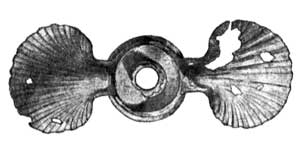 |
 |
| Fig. 575a |
Fig. 575б |
- This catacomb is 4 arch<ines> long, 4 arch<ines> and 8 versh<oks> w<ide>, and 2 arch<ines> and 6 versh<oks> h<igh>, with the passageway to the e<ast> and six niches, two in every wall. This catacomb undoubtedly was plundered in a later period, as all the bones were heaped near one wall and there was no pottery or any other artifact on the floor and on the beds.
- This catacomb has rough finish and is 2 ½ arch<ines> long, 4 arch<ines> w<ide>, and 2 arch<ines> and 7 versh<oks> h<igh>, with the passageway to the e<ast> and no niches. The passageway was blocked by huge base of sandstone. There were three skeletons oriented with the heads to the <east> and accompanied with 2 single-handled earthen<ware> juglets; 4 single-handled earthen<ware> cups; 2 earthen<ware> lamps without images; bron<ze> key with wide ring for carrying it on a finger; 2 circular ribbed beads of green paste; 3 beads of paste with multicolored eyes; bron<ze> coin of the emperor Valentinianus I (364-375).
- —794. Five underground tombs. No artifacts were uncovered with the skeletons.
- Underground tomb that contained plain earthen<ware> lamp and pair of bron<ze> ring-shaped earrings.
- Similar tomb that contained single-handled earthen<ware> cup and earthen<ware> lamp without images.
- This is catacomb 4 ¼ arch<ines> long, 4 arch<ines> w<ide>, and 2 arch<ines> and 7 versh<oks> h<igh>, with passageway to the e<ast> and 3 usual type niches. The entrance slab was not fixed with mortar but simply leaned to, in result of which the catacomb was filled with soil up to its doorsill. In this soil and on the shelves there was a huge number of bones; to place all these bones on the shelves, boards were put from the side of the catacomb; one of the skulls appeared to be deformed. The soil contained: circular plate of sheet copper, 1 ?" in diameter, with eyelet and cross of dots pressed in most primitive way; bron<ze> closed-bell-shaped button; 12 bron<ze> earrings in the form of fine rings (usual finds for the tombs at churches), and bron<ze> coin of the emperor Leo I (457-474).
Taking the described finds into account, it is possible to consider this burial Christian, though the huge, unknown before, number of skeletons, the lack of pottery and other artifacts suggest that this catacomb probably was not family but "communal" grave
[34]
.
 |
| Fig. 576 |
- This catacomb is 5 arch<ines> long, 4 ½ arch<ines> w<ide>, and 2 ½ arch<ines> h<igh>, with passageway to the e<ast> and six niches in two tiers, two in each of the three walls, and tetrahedral pillar in the middle, alike in catacomb no. 680. On the floor, there were decayed boards of five coffins oriented with the heads to the w<est>. The bones both on the floor and on the shelves decayed completely. The skeletons were accompanied with 7 earrings of thin gold badge in the form of hemisphere with wire hook (2 have hook of special form; 3 earrings have hook put through the hole in the centre of hemisphere in a primitive way); earring in the form of leaf of thin g<old> badge, with wire ring, loop and hanging g<old> ball
(fig. 576)
; нsmall earring of g<old> wire; gold oval leaf to cover mouth; 2 g<old> oval leaves of the same size that were probably used to cover eyes and replaced usual double leaves in the form of spectacles; big impression of coin made of compact gold badge with unclear image, and 5 small gold impressions of coins (4 with illegible images and the fifth one with impressed head wearing helmet, facing right); jet ring; 2 earthen<ware> juglets (one single-handled, another handless, with narrow neck); 6 earthen<ware> single-handled cups; grooved handleless cup; 4 earthen<ware> saucers with high foot; 4 earthen<ware> bowls (one is big, 9 ½" in diameter); gl<ass> globular bottle, 5" high, with short neck decorated with double circles carved into its surface; 10 earthen<ware> lamps without images; finger-ring of dark glass (top decoration in the form of yellow glass head of Medusa is broken off); gl<ass> circle with one side convex; 4 bron<ze> ring-shaped earrings; bron<ze> tube with 2 loops on the ends; round glass from a finger-ring; bracelet consisting of seven big glass pierced beads in the form of ribbed bisected balls with two holes; pendant of black paste with yellow strips in the shape of modern looped weights; 10 amb<er> amphora-shaped pendants; various beads (18 tetradecahedral carnelian pieces that could compose a bracelet; 2 circular pieces of rock crystal; 4 of green paste, ribbed and circular; 18 fine ribbed of black paste; big circular one of paste, with multicolored festoons; 4 of paste with multicolored strips, elongated; 2 elongated jet; 14 amber in the form of flat circles; big flat oval amber; 8 tetradecahedral of blue glass; 3 of the same material in the form of flat circles; 24 circular of multicolored glass; 39 elongated of the same material); 10 bron<ze> coins of Chersonesos (Bur<achkov, Op. cit.>, pl. XVI, 89, 91, 96, 103, 108, 109, 114, 115 -it is a variant as the inscription under the star goes from bottom to top; 118 and 120 - countermark on worn off coin); 2 bron<ze> coins of the Roman emperors Constantine the Great (306-337) and Arcadius (395-408).
- Underground tomb that contained: single-handled earthen<ware> juglet, single-handled earthen<ware> cup, and earthen<ware> lamp without images.
- Similar tomb that was located above catacomb no. 798. There was big earthen<ware> bowl.
- -802. Two underground tombs were located partly above catacomb no. 797. Single skeletons were not accompanied with artifacts.
- This underground tomb contained earthen<ware> bowl and lamp without images.
- Similar tomb that contained red slip vase with ivy wreath around that was made by yellow paint.
- Similar tomb that contained 2 black slip earthen<ware> double-handled vases, of excellent technique.
- This tomb is laid of 6 stone slabs with holes carved into them for fixing pointed decorations (s<ee> the description of tombs nos. 715 and 726). It contained 3 earthen<ware> double-handled urns with fired bones and high bron<ze> cuff link.
Behind the wall that makes a right-angle turn to the w<est>, there was crushed globular pithos (let<ter> ж) covered with marble slab fragment. After passing 7 archines, the wall makes another right-angle turn to the n<orth> and goes parallel to the first wall. The area encircled with these three walls includes, besides the crushed pithos, 6 tombs as below.
- Underground tomb that contained 2 single-handled juglets.
- -812. Five tombs were cut into bedrock and were not covered with slabs. Singular skeletons were not accompanied with grave goods.
The mound of the same area in the necropolis contained narrow-neck handleless earthen<ware> vessel; similar vessel in the shape of alabaster; black-clay tureen; single-handled earthen<ware> juglet flaring neck and spout; black slip earthen<ware> lamp; 2 thr<owing> stones: 1 earthen<ware> sinker for fishing net in the form of truncated pyramid; 8 stone pointed top decoration for gravestones, and 2 fine quadrangular stone slabs with carved slots to fix the above decorations.
The excavations in vicinity of Chersonesos on St. George's monastery land, on the sea coast, near cape Fiolent
These excavations discovered the following sites of the ancient structures
(s<ee> the plan on fig. 577 as attached)
.
 |
| Fig. 577 |
I. Altarless church. Its chancel was plastered and covered with frescoes, remains of which are on fragments of wall plaster uncovered from the ground. Marks a-a indicate where stone benches ¾ arch<ine> wide and 6 versh<oks> high were arranged along the walls. The choir screen is greatly damaged.
II. This long narrow room, 15 ½ arch<ines> long and 5 ½ arch<ines> wide, is connected with the altarless church via door б.
III. Square room (6 arch<ines> х 6 arch<ines>) with its west wall preserved as high as 1 ¼ arch<ines>. The finds: millstones from hand mill; fragment of marble cornice; splinter of marble slab, and fragment of marble slab with carved into it image of cross with the arms spread outward, within circle 7 versh<oks> in diameter.
IV. This pantry is 2 ½ arch<ines> long and 2 ½ arch<ines> wide. It contained a number of glazed earthen<ware> pottery shards, and namely: juglet (broken), 7" high, single-handled, with flattened neck; bowl (broken) with 4 holes, located symmetrically, for fastening its fragments, with impressed image of a monster with downy tail
(fig. 578)
; bottom of another bowl of green color, with impressed brown monogram
(fig. 579)
, and 25 unidentifiable shards.
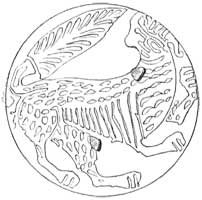 |
 |
| Fig. 578 |
Fig. 579 |
The masonry type and uncovered artifacts prove that this small monastery and the reconstruction of the churches and altarless churches, which have been discovered in Chersonesos, date to the same period. Similar to the ones from Chersonesos, all the rooms have traces of a conflagration that damaged the pottery as well.
The said buildings are located in a picturesque wild area, lower than the cyclopean construction mentioned in Z. A. Arkas's work (Opisaniye Gerakleyskogo poluostrova i drevnostey yego [A description of the Gerakleyskiy peninsula and its antiquities]), no. 5 on the plan, slightly before the cape Fiolent, atop steep cliff in the form of a ship that projects into the sea and is inaccessible on three sides. On the north-east, the monastery and its narrow strip of land covered with wild vines and bushes are protected by high vertical cliff, from where it is possible to descend, with difficulty, by a path and stairs that were possibly carved into bedrock by those who lived in this area in ancient times. This steep cliff has several caves, a half of which was undoubtedly made by nature, and a half by man. There is a source of excellent cold water near the caves. All this narrow and long strip in the form of semicircle faces s<outh> and, according to the abundance of vines and stumps from Lombard poplars, was planted and belongs perhaps to the monastery, the site of which was discovered by me in May of the year under report. I believe that this picturesque nook was populated as long as the time of the mysterious cyclopean constructions that were spread through the whole peninsula; one of such structures, which was mentioned above, is located above the precipice, at the beginning of the staircase and the path going to the spring.
The continuation of the excavations may result in discovery of ancient catacombs or some epigraphic monument in this area.
|


